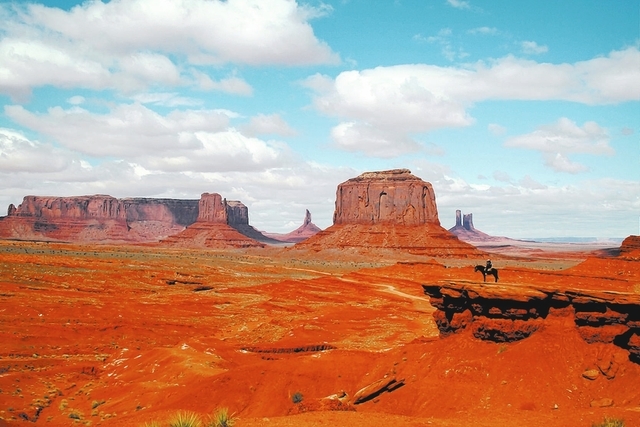Monumental history to be found in Native American valley

Monument Valley Navajo Tribal Park is home to some of the most stunning buttes, mesas, arches and panoramas in the world. So familiar are some of these views, through Western films and television, that even an informal mental list of things to do before “kicking the bucket” often includes seeing them in person. The fall and winter months are appropriate for the visit, all the more so because many closer attractions on federal land have been closed due to the budget gridlock. This park lies not on federal land but on the 16 million-acre Navajo Reservation, so it remains open.
The 30,000-acre park was established in 1958, but the Dine’, as the Navajo people refer to themselves, have occupied this area for more than 400 years. Prior to that, Ancestral Puebloans made homes here.
For Southern Nevadans, getting to the park requires a fairly long all-day road trip, not counting the visit itself and the return journey. Yet it’s worth investing that much time because the scenery is unlike anything else you will ever see, and because the region is so remote, you won’t have to fight crowds while enjoying it.
The best way to experience the park and see the more remote areas is by signing up for a guided tour. The motor vehicle tours are worthwhile, but many who can afford the time prefer a horseback version. The horseback tours, especially the full-day ones, will get you off the beaten path to see vistas and cultural sites unavailable from the roads, and you’ll see them surrounded by the profound quiet of the desert.
You can visit at your own pace by taking a 17-mile self-driving tour. First be sure to pick up the View Scenic Drive Brochure, which will fill you in on the names and places of the highlights along the way. And be warned: This drive takes you along a semi-loop gravel road and can be rough in some places, so a high-clearance vehicle with good off-road tires is a must.
One of the valley’s most iconic formations is visible from guided tours and self-driven tours alike: the Totem Pole. This is a thin spire that rises to an incredible height, about 500 feet over the valley floor. It is instantly recognizable because it has been used many times for TV and film locations; among them have been TV commercials for IBM and Jeep and a movie starring Clint Eastwood, “The Eiger Sanction.”
Other films shot partly in Monument Valley include “How the West Was Won,” “Back to the Future III,” “Thelma and Louise” and “Forrest Gump.” The valley’s list of film and magazine credits continues to grow rapidly.
Monument Valley Navajo Tribal Park is open year-round. There is a $5 per-person entry fee, but children 9 or younger get in free, as do members of any Native American tribe. The scenic drive is open from 8 a.m. to 4:30 p.m. October to April and 6 a.m. to 8:30 p.m. May through September. For more information, visit navajonationparks.org or call 435-727-5874.
Overnight accommodations can be found at Goulding’s Lodge, which offers rooms, suites, cabins and a campground, 5½ miles from the park entrance. For more information, visit gouldings.com or call 435-727-3231. The View Hotel is in the park, and each unit has a private balcony looking out on one of Monument’s Valley’s most iconic views, The Mittens. For more information, visit monumentvalleyview.com or call 435-727-5555.
There are gas stations, restaurants, medical facilities and other services available throughout the reservation, although most are not near each other. All main roads are paved. No alcohol is sold on the reservation. Arizona does not participate in daylight saving time, but the Navajo Nation does. So during daylight saving time, which ends for the year Nov. 3, Utah and the Navajo Nation are one hour later than Arizona and Nevada. In non-daylight saving months, Arizona, Utah and the Navajo Nation are on Mountain Standard Time, one hour ahead of Nevada.
Deborah Wall is the author of “Great Hikes, A Cerca Country Guide” and “Base Camp Las Vegas: Hiking the Southwestern States,” published by Stephens Press. She can be reached at deborabus@aol.com.
Directions
From Las Vegas, take U.S. Highway 93 south for 105 miles to Kingman, Ariz. Go east on Interstate 40 for 150 miles to Flagstaff. Take Arizona state Route 89 north for about 63 miles and turn right onto U.S. Highway 160 and follow for that for 82 miles. Turn left onto U.S. Highway 163 and drive 24 miles to the signed park entrance road on the right.












